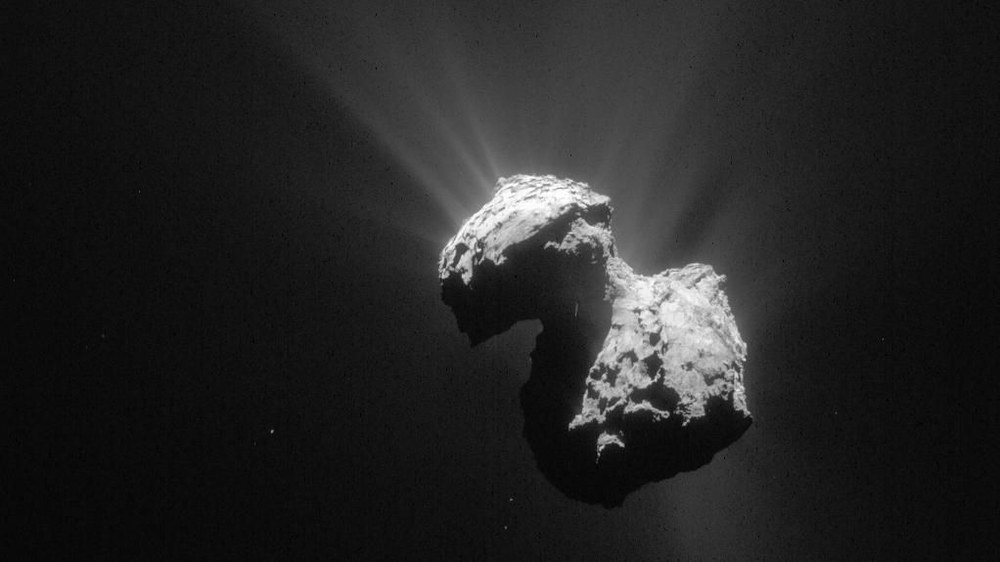Ten years ago: Philae becomes first probe to land on a comet

ESA/Rosetta/Navcam
For some, it feels like just yesterday; for others, it's like an entire era of comet research. Ten years ago, on 12 November 2014, the Philae lander made the first-ever landing on a comet in the history of space exploration.
Not everything went as planned, but perhaps that's precisely why those November days a decade ago were so thrilling. The teams involved had to adapt rapidly to unforeseen circumstances and devise new scenarios on the fly. Despite the many challenges, Philae impressed as it sent fascinating data and images from the comet's surface.
The 'potato' turns out to be a 'rubber duck'
But let's recap: The European Space Agency's (ESA) Rosetta spacecraft, carrying the Philae lander, was launched over 20 years ago on 2 March 2004 aboard an Ariane 5G+ rocket from Europe's Spaceport in Kourou, French Guiana. It travelled for ten years, including a 'hibernation phase' from June 2011 to January 2014, before finally reaching its target, comet 67P/Churyumov-Gerasimenko, in the summer of 2014. Little was known about the comet beforehand, and there was great surprise when its nucleus did not appear as a 'rounded potato', as previously assumed, but as a 'contact binary' (two connected objects) roughly resembling a rubber duck. Accordingly, selecting the safest possible landing site for Philae proved a challenge. Ultimately, the most suitable spot turned out to be on the 'head' of the duck, a region later named 'Agilkia', after the island on the Nile where the original Philae temple once stood.
The landing sequence, meticulously planned in advance by teams at the European Space Operations Centre (ESOC), the French space agency (CNES) and the German Aerospace Center (Deutsches Zentrum für Luft- und Raumfahrt; DLR), began a few days before the actual landing. Rosetta was placed on the necessary trajectory to deploy Philae from an altitude of approximately 22 kilometres. On 11 November (coinciding with the start of the carnival season in Cologne), the lander was activated and a few problems quickly emerged: the central computer had to be rebooted, a valve for the cold gas system didn't open as planned and the battery conditioning didn’t go quite according to plan. Should the landing be postponed for several weeks?
Landing with a twist: Philae's unexpected bounce
After careful consideration, the decision was made to proceed with the landing. In the end, all systems functioned nominally (with the exception of the cold gas system, for which all attempts to open the valve had been exhausted – delaying the landing would not have provided any benefit).

ESA/Rosetta/MPS for OSIRIS Team MPS/UPD/LAM/IAA/SSO/INTA/UPM/DASP/IDA
And so, it began: On 12 November at 09:35 CET, Philae separated from Rosetta at a speed of approximately 18 centimetres per second, descending towards the comet for about seven hours. Philae hit the targeted landing site very precisely at a speed of approximately 3.6 kilometres per hour. Cheers erupted! Almost everyone. It quickly became evident that the cold gas system (intended to press the lander onto the surface) and the anchoring harpoons had both failed. Philae had bounced off and was moving (as clearly indicated by the housekeeping data), drifting off to an unknown location.
The good news was that stable radio contact was maintained through the Rosetta mothership. The bad news: We didn’t know where and for how long Philae would keep 'hopping'.
For two very intense hours, this continued until the lander finally came to rest. This meant Philae had indeed landed on the comet (for the second time) and was still transmitting data.
The following day, analyses of the images from OSIRIS, the orbiter's camera that had captured Philae's descent and bounce, along with radio signals and data from the onboard CONSERT radar instrument, revealed the approximate landing site. Philae had bounced nearly a kilometre across the comet’s surface, into an intriguing but unfortunately very shadowy area.
Despite its short life, Philae sent a wealth of data
The Sun illuminated Philae for only about one hour and 20 minutes per comet day (approximately 12 hours). This was sufficient to capture images and operate all instruments, but too short to recharge the batteries and sustain the lander continuously.
After approximately 64 hours, the batteries were depleted, but the time was used to learn as much as possible about the surface of 67P/Churyumov-Gerasimenko. High-resolution images of its surface were captured, mass spectra recorded, magnetic field measured, the interior of the comet’s nucleus scanned with radar and the hardness of its surface material determined. This treasure trove of data spectacularly complemented the findings transmitted to Earth by the Rosetta orbiter, up until September 2016.

ESA/Rosetta/MPS for OSIRIS Team MPS/UPD/LAM/IAA/SSO/INTA/UPM/DASP/IDA
One aspect of the mission, however, was missing ten years ago. Something that was eagerly anticipated both scientifically and emotionally: an image captured by the orbiter showing Philae at its landing site, where it would likely remain for many more orbits around the Sun.
This was finally possible in September 2016, during the final days leading up to the end of the Rosetta mission. We see Philae 'parked' in a crevice, slightly tilted and unanchored but otherwise intact – as an earthly envoy on a comet!
Today, our understanding of comets is largely shaped by the findings of the Rosetta mission; its data continues to be used to gain new insights. However, new missions are also on the horizon. ESA plans to launch the 'Comet Interceptor' mission in 2029 – a probe that will wait at the second Lagrange point (L2) to intercept and study a long-period comet during its flyby.
The next significant milestone in comet research will likely be a sample return mission, which would bring comet material back to Earth for analysis by advanced instruments in terrestrial laboratories. Both the Japanese space agency JAXA and NASA are planning such missions – and we at DLR hope to contribute to these efforts.
Related links
Tags:
